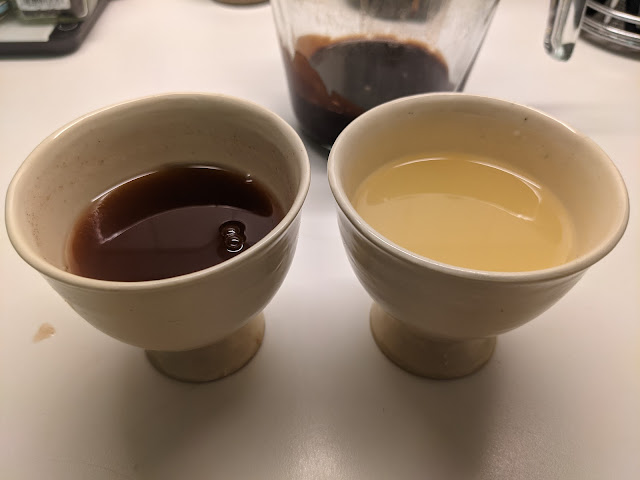Historical Unit Sizes
In the recipes so far, I've been working on the assumption that 10 sheng is one dou, and ten dou is one dan, based on the entries for those characters in A Student's Dictionary.
I'm writing up the lesson plan for the class I'm teaching at Pennsic (Zidian and Cidian: Chinese Dictionaries) and as I was paging through Wang Li's Classical Chinese Dictionary, I noticed that one of the appendixes has unit conversions. What's more, it has dated unit conversions, with a list of textual and archaeological evidence to back them up.
This doesn't really change the recipes since they scale, but it's interesting. What volumes are the recipes actually calling for?
According to Wikipedia, the Qiming Yaoshu was finished in year 544 CE and took perhaps ten years to write. This places it during the Eastern Wei dynasty. Unfortunately, there is no entry for the Wei dynasty at all, but it's one of the Southern and Northern Dynasties (南北朝), which we do have an entry for.
The leftmost column gives the dynasty, and the second from the left gives the unit conversions:
1 hu 斛 = 10 dou 斗
1 dou 斗 = 10 sheng 升
1 sheng 升 = 10 ge 合
The next column is textual supporting evidence:
From the Book of Sui, the Treatise on Rhythm and the Calendar: "In the Qi dynasty, they took the old sheng, five sheng to one dou."
I'm a little confused by this, but presumably the dictionary compiler had some context and a reason for giving a conversion of 1:10.
The next column I believe is something like the approximate volume of a hu in milliliters, so it's saying that in the Three Kingdoms period a hu was something like 20.45L.
The next column is archaeological evidence: "The Chinese National History Museum has a Jin dynasty copper cauldron, and following the chromium, 'accommodates a sheng.'"
The next column is the volume of that cauldron, which is 535 mL. Hardly a cauldron.
The last column is a list of the volumes of the various units in mL, according to the compiler:
hu 30L
dou 3L
sheng 300mL
ge 30mL
If we take these units at face value, and still treat one dan as 10 dou, then the lumpy yeast cake wine recipe is nominally for ten seven-dan vessels, or ten 210L vessels, or 2,100L total. 210L is about 55 gallons, which very interestingly is almost exactly the size of a common metal or plastic drum! That's a pretty big clay pot, but probably not one that's totally unmanageable, at least when empty.
I'm writing up the lesson plan for the class I'm teaching at Pennsic (Zidian and Cidian: Chinese Dictionaries) and as I was paging through Wang Li's Classical Chinese Dictionary, I noticed that one of the appendixes has unit conversions. What's more, it has dated unit conversions, with a list of textual and archaeological evidence to back them up.
This doesn't really change the recipes since they scale, but it's interesting. What volumes are the recipes actually calling for?
According to Wikipedia, the Qiming Yaoshu was finished in year 544 CE and took perhaps ten years to write. This places it during the Eastern Wei dynasty. Unfortunately, there is no entry for the Wei dynasty at all, but it's one of the Southern and Northern Dynasties (南北朝), which we do have an entry for.
The leftmost column gives the dynasty, and the second from the left gives the unit conversions:
1 hu 斛 = 10 dou 斗
1 dou 斗 = 10 sheng 升
1 sheng 升 = 10 ge 合
The next column is textual supporting evidence:
From the Book of Sui, the Treatise on Rhythm and the Calendar: "In the Qi dynasty, they took the old sheng, five sheng to one dou."
I'm a little confused by this, but presumably the dictionary compiler had some context and a reason for giving a conversion of 1:10.
The next column I believe is something like the approximate volume of a hu in milliliters, so it's saying that in the Three Kingdoms period a hu was something like 20.45L.
The next column is archaeological evidence: "The Chinese National History Museum has a Jin dynasty copper cauldron, and following the chromium, 'accommodates a sheng.'"
The next column is the volume of that cauldron, which is 535 mL. Hardly a cauldron.
The last column is a list of the volumes of the various units in mL, according to the compiler:
hu 30L
dou 3L
sheng 300mL
ge 30mL
If we take these units at face value, and still treat one dan as 10 dou, then the lumpy yeast cake wine recipe is nominally for ten seven-dan vessels, or ten 210L vessels, or 2,100L total. 210L is about 55 gallons, which very interestingly is almost exactly the size of a common metal or plastic drum! That's a pretty big clay pot, but probably not one that's totally unmanageable, at least when empty.




Comments
Post a Comment